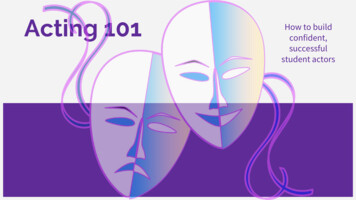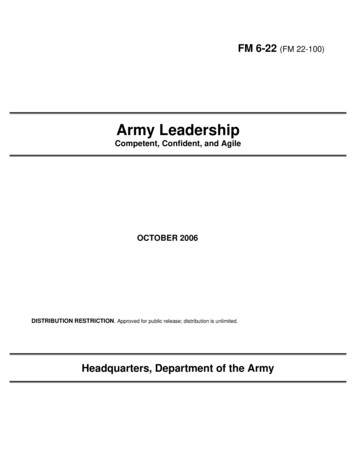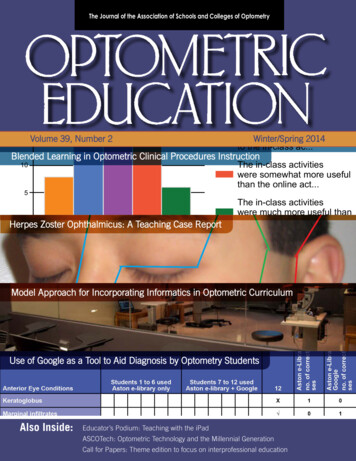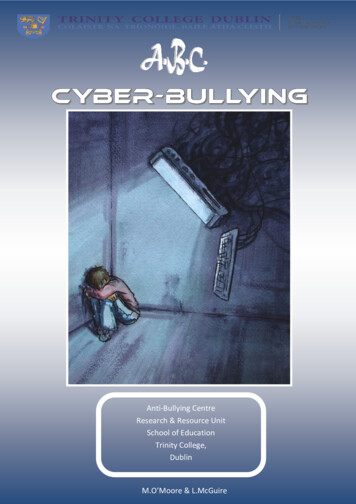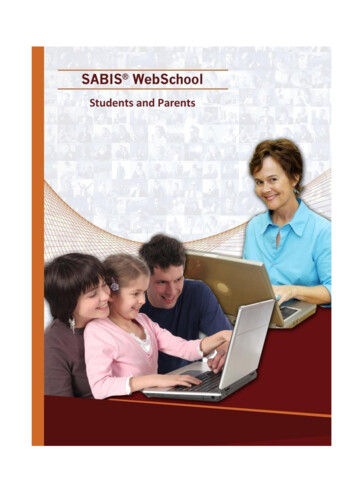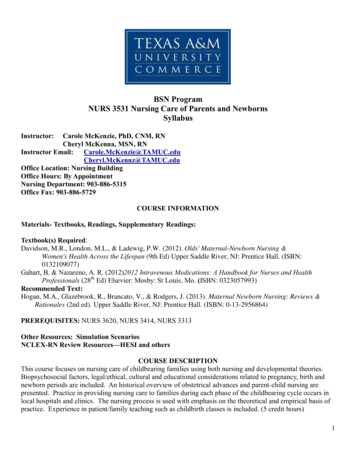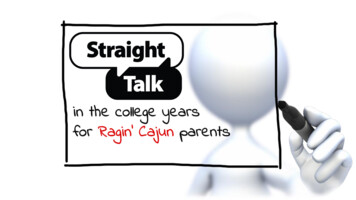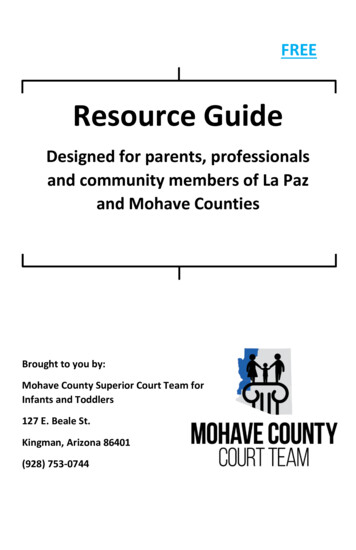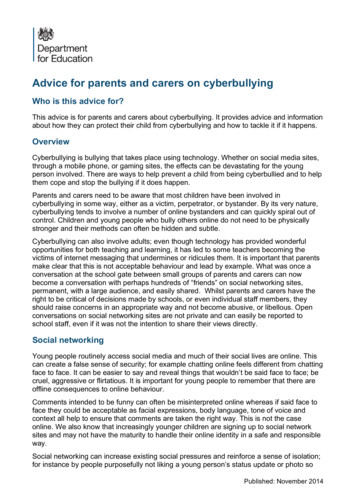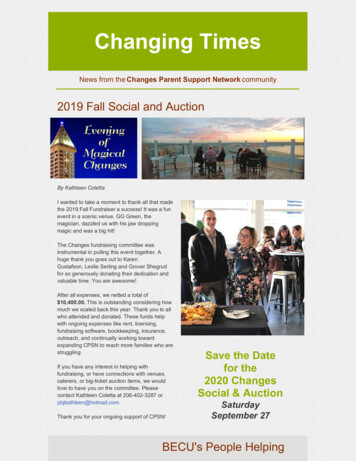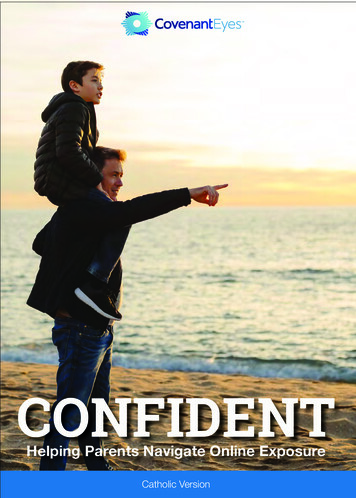
Transcription
CONFIDENTHelping Parents Navigate Online Exposure1Catholic Version
How to Use This BookThis book will take you about an hour, give or take, to readfrom cover to cover. The chapter titles and section headingsare meant as a guide to help you find the most relevantportions for your situation.We recommend you read the entire book before having adiscussion with your child or teen about pornography. It isworth being as educated as possible because your child isworth it.»In the first part, you’ll learn about why having adiscussion about porn is important, especiallywhen your child has already been exposed to it.»In the second part, you’ll learn how to preparewell for this discussion.»In the third part, you’ll read about having theconversation.»In the last part, you’ll learn about practical nextsteps to prepare your home.As parents, we must keep in mind that there are no quickfixes or easy solutions to this kind of situation. The goal ofthis book is not to “fix your kid,” but to provide you a way of2
thinking about growing your relationship with your child asyou provide him or her with guidance and formation he orshe needs.This book may take you deeper than you desire to go. It maybe very uncomfortable at times. Embrace this. When wesettle for quick tips and easy answers, the real underlyingproblems in life are not addressed.3
Table of Contents05 Introduction08 Chapter One: Porn Impacts Children12 Chapter Two: The Stages of Porn Use15 Chapter Three: Preparing to Talk21 Chapter Four: How to Talk Through It28 Chapter Five: Sex is God’s Good Idea37 Chapter Six: It Starts At Home43 Conclusion45 Frequently Asked Questions62 Resources63 References
IntroductionShe sat down to enjoy a cup of coffee and check heremail on her iPad. Trying to find a website she visited the daybefore, she opened the browser’s history. Instead, what shefound completely shocked her. One after the other, a list ofsexually explicit titles of pornographic websites appeared inthe history log.Slightly panicked, but paying careful attention to the details,she noticed these sites were all accessed in the afternoonthe day before. Her husband had been at work then, so itwasn’t him. Then she remembered letting her 11-year-oldson borrow the iPad to play some games. Reality sank in.From what she could tell, her son had spent at leastan hour or so glancing through these pages.5
The question that plagued her was: What should shedo now?This resource will help you answer this question. Wewill provide practical steps that any Catholic family canimplement in their home right now regardless of whethera young person is actively looking at pornography or not.The statistics surrounding porn consumption in youngpeople are shocking. According to one survey conductedat a large, Catholic high school in 2017, 49% of studentswho completed the survey responded that they seek outporn more than once per week.1Distressing as this might seem, your discovery of your child’sporn viewing is not unique. These are not uncharted waters.Millions of parents have faced this situation. Millions havewondered how to handle this. Millions more will face thissituation in the future. The critical question is: Will theyface it well?You, as a parent or guardian, must know at the outset thatfinding evidence of your child looking at pornography canbe very upsetting, but this is not the end of the story.Do not panic. Let me say it again – stay calmand do not panic!6
There are changes you can make as a family to protectyour child from the dangers of pornography.As a parent, the wisdom you impart and the example yougive to your kids at this critical time in their lives has thepower to lead them their entire lives. Your wise guidanceand example can equip them to not give into sexualtemptation and embrace a life of chastity and holiness.7
01.Porn Impacts ChildrenReality: Many boys and girls are looking at pornPorn used to be hard to come by for young people. Kidswould have to stumble on a parent’s or uncle’s “stash” ofmagazines or video cassettes (or get it from another childwho did). Today, this is not the case. The internet has madesexual content available in nearly every home—and to anyage. According to a survey of today’s college students,more than half of men and a third of women say they firstsaw pornography before their teenage years.2It isn’t just boys, either. If there ever was a time in our culturewhen porn was an exclusively male habit, that time is longgone. While it is still generally true that girls are less likely toseek pornography, about a quarter of young girls, on at least8
one occasion, will spend 30 consecutive minutes or moreviewing pornography online.3In adulthood, 20-30% of women become regular consumersof pornography or participants in sexually explicit chat rooms.4And girls are actually more likely than boys to becomesomeone else’s pornography by sending nude or semi-nudepictures or videos of themselves online.5“This material is more aggressive, moreharmful, more violent, more degradingand damaging than any other time in thehistory of the world. And this generationgrowing up is dealing with it to anintensity and scale no other generation inthe history of the world has ever had to.”— Clay Olsen, Co-Founder and CEOof Fight the New Drug6Is it any wonder that when a child or adolescent is directlyexposed to pornography, the following effects have beendocumented?7»» Having sexual intercourse earlier.»» Lasting negative and traumatic emotionalresponses to seeing porn.9
»» The belief that the best sexual satisfactionis attainable without having affection forone’s partner.»» The belief that being married or havinga family are unattractive prospects.»» An increased risk for developing sexualcompulsions and addictive behavior.If your child is exposed over and over to incorrectinformation about human sexuality, long before heor she is able to understand this information, theresult could be a lifetime of hurt.Parents Must Act NowThese facts are not presented here just to be shocking,but rather to bring us a healthy dose of reality.One of the most powerful tools we have when it comes toteaching our children about the beauty of their sexuality inthe digital age is conversation. Real, honest, “look them inthe eyes” conversations about their deep questions. In thedigital age, passive parenting is not an option – the Internetnever rests. Parents must engage actively with their childrenon the deep questions of their hearts even if it’s awkwardfor them and/or you. It’s important. The constant flood of10
influence that comes throughthe internet and social mediaOne exposure [to porn]in all of its various forms,can create a lifetime ofalong with social pressuresviewing and strugglingfrom peers and their poorchoices make it difficult for achild of God to live a virtuous life.And, regrettably, all of this,including internet pornography, is teaching our childrenhow and what to think about sex and marriage. Again,in the digital age, it’s not a matter of if your child will seesomething inappropriate online. It’s only a matter of when.Regrettably, at least once a month, 49% of teens stumbleacross porn.8 One exposure can create a lifetime of viewingand struggling.As parents, the time to act is now. As awkward as talkingto our kids about porn is, the cost of not talking about it istoo high. Sex is a God-given gift, and we do not want ourchildren to see it cheapened by pornography.11
02.The Stages of Porn UseIf your child has been exposed to porn, your response shouldbe based, in part, on how deeply your child is into porn andhow long it has been going on. Keep these stages in mindas you read the rest of this guide.Stage 1: Experimentation and CuriosityMost initial porn viewing that happens in childhood, or eventhe teen years, is born out of curiosity. Boys want to knowwhat the girls look like with no clothes on, and vice versa.Before puberty, it is natural for boys and girls to be curiousabout gender and the sexual differences. During puberty, assexual feelings grow, it is also common for boys and girls tobe drawn by provocative images online, desiring to see more.12
Stage 2: Regular Use for MasturbationIn this stage, your child has gone from curiosity to “using”porn or online chatting for sexual gratification and orgasm.While this stage is more common among teens, youngerchildren can also enter this stage. In this stage, whilethere may be feelings of shame, the porn use is seenas recreational.Stage 3: Risky UseWhat constitutes “risky use” is not the same for all children.The almost undetectable shift into this stage happens whenkids start to seek porn despite the negative consequences.They might stay up late into the night binging on porn, losingsleep and the ability to focus during the daytime, only toreturn to porn the next night. They might start looking at pornin riskier settings (at school, with a parent’s smartphone, whensomeone could walk in at any moment, when they should bewatching a younger sibling, etc.). Getting caught is less ofa concern to them, and in fact, the fear of it becomes partof the “high” they get from the experience.Stage 4: Dependence and AddictionMasturbating to pornography taps into the neurocircuitryof our brains, signaling the release of dopamine, serotonin,opiates, oxytocin, and other hormones and neurotransmitters.13
This hormonal cocktail is part of our body’s natural responseto sexual activity, but when combined with graphic porn,the brain experiences a sexual “high” at unnatural levels.Those who have developed an addictive relationship topornography experience an overwhelming craving forporn, seemingly uncontrollable sexual fantasies, and evenwithdrawal symptoms. The types of porn that used to satisfyno longer do; harder and more graphic pornography issought.There are no hard lines between these stages, but they existon a continuum.14
03.Preparing to TalkRealizing your child has been accessing porn repeatedlycan be frightening, upsetting, and unnerving, but withsome preparation, you can have an informed and productivediscussion with your child about it.Our conversations with our children are to direct themto real love. The goal is to help them see their bodies asbeautiful gifts to offer and not objects to be used in theway that internet pornography teaches. Online influences,especially pornography, tell kids many horrible lies. Themillions of pornographic images and videos available onlineand in apps kids use daily communicate the lies that sexcan be casual and that people are objects to be usedand discarded.These exact same electronic devices that we depend onas parents to stay in touch and have a sense of safety and15
security with our children are the verysame devices that give our childrenOur conversations witha doorway into pornified contentour children are to directthat diminishes innocence,them to real lovechallenges holiness and confusesrelationships, sometimes for a lifetime.If at all possible, delay having theconversation with them for a day. If you find out on Tuesdaythat your child has accessed pornography, there’s no harmin waiting until Thursday or Friday to talk with them. You needtime to process what you need to say and how you need tosay it.Do Your HomeworkYou should know as much as you possibly can aboutyour child’s porn viewing experiences before you havethe conversation.Check the browsing history of any internet device in thehome. If you have multiple browsers (like Firefox, InternetExplorer, Safari, Chrome, etc.), open them all and accessthe history. Look back several weeks, or even months if youcontinue to find evidence of porn viewing. Take note of thetypes of sites that were accessed. Check any browsing appson mobile devices as well.16
If the history logs on these internetbrowsers appear to be blank, this isan indication that someone hastampered with the data. Thismight have been yourchild, which meansthey are not only savvyenough to cover theirtracks, but also desire notto be caught. Among teensthis is very common today. Accordingto a recent survey, 71% of teens have done somethingto hide their online behavior from their parents.9It is relatively easy to use internet browsers in “incognito”mode (sometimes called “private browsing”). This is a settingthat can be easily turned on and off, giving the user thepower to hide all their Internet activity from the history logs.Use a browser’s “autofill” feature to give you some hintsabout what search terms were used. Often, previouslysearched terms will appear as you start to type in the searchbar. Walk through the alphabet, typing a couple letters ata time, and see what search terms may have been used.Perhaps your daughter was searching for “what is sex.”Perhaps your son has a crush on a cheerleader at school,so he typed in “cheerleader.” Perhaps your child saw abillboard for Hooters and looked it up. Perhaps your childheard a sexual word at school that they wanted to know17
about. Or maybe your child has been into porn or eroticchatting for a while, and he or she is searching for moregraphic terms.If your child has a smartphone or tablet, review all theinstalled apps. Some apps may be disguised as innocentapps (an app labeled “Calculator!” may actually be for tradingporn, for example). Other apps, such as Instagram andSnapchat, contain back doors to sexually explicit images.Make sure you set up restrictions to prevent installing apps!Use iPhone ’s built-in Screen Time settings. On Android ,install an app locker (the Covenant Eyes app contains one).The goal of this knowledge is not to say “Gotcha!” When youquestion your child about what they were looking at and why,you are likely to hear the phrase like, “I don’t know,” a coupledozen times. Having this conversation will probably be verydifficult for your son or daughter. The more informationyou can volunteer, the less of a burden he or she will haveexplaining everything to you from start to finish. “I noticedyou were searching for ,” you might say. “What madeyou curious about that?”Talk It ThroughIf you are married, talk with your spouse about the situation.Listen to one another’s perspectives.If you have a trusted mentor or priest you can speak with,confide in them about the problem. Listen to how they might18
approach the situation. It goes without saying, these arepeople you need to be able to trust not to gossip about thisinformation with others.As you listen to others, take time to “rehearse” the thoughtsgoing through your mind out loud. Get feedback from othersabout what you say and your tone.If you find yourself bewildered by what your child is lookingat (i.e. a feeling of “I just don’t get why my child likes lookingat this stuff”), try to find someone who can relate to this areaof temptation.Pray About ItThe most important thing you can do to prepare is to askGod to give you compassion for your child. If your gut instinctis fear, ask God to take away your timidity. If your gut instinctis a sense of parental failure or shame, ask God to instill in youa deeper sense of trust that His love andmercy is greater than any mistakesyou have made as a parent.If you are angry, ask Godto fill you with a deepsense of compassionfor your child.Pray that God will changeyour attitude into one that will19
not distance your son or daughter from you or the Lord.Go to Mass and offer your child and the conversation as yoursole intention. You may also want to consider participating inthe Sacrament of Reconciliation as you prepare for the firstconversation with your child.Brace Yourself For More Than OneConversationThe end goal is not having one conversation with yourchild but maintaining a type of relationship with your sonor daughter that communicates safety and acceptance.This paves the way for future conversations.Since there is a lot that can be said about pornography andsexuality, the material in the pages that follow might need tobe stretched over several conversations.Remember: Tone Is EverythingWell, almost everything. Certainly, what you say to yourson or daughter is important, but how you say it will becritical. It is likely that your child or teenager is experiencingsome fear, uncertainty, shame, or guilt about having viewedpornography. It is very important that in your conversationswith him or her you do not approach the situation with sharpcriticism or an overbearing sense of fear, bewilderment,or shame.20
04.How to Talk Through ItOpen the DialogueDon’t surprise your child or teen with this conversation. Talkto your son or daughter beforehand. Say, “I notice you don’thave anything on your schedule on (planned date), so thereare a few things I want to talk to you about. I need some ofyour time.”When you begin the conversation, start with what you know.Tell the story of the discovery of the evidence and why youbelieve he or she is the one who was looking at the sexualcontent.Give him or her time to respond. Ask if your observationsare correct.21
The point of this step is to feed themwhatever you know to help them begintalking. They may admit to everythingand talk for quite a while. They maybe very silent, unsure of what to say.Don’t feel the pressure to make themsay anything specific. This stepis just about helping themto open up.What if they deny it?Stay calm. Inevitably, some children or teens will respond bylying, denying they are the ones who saw the sexual images.If this happens, it is important not to lose sight of the biggergoal. This is a teachable moment between you and yourchild. It is a time for you to impress on him or her importantlessons about human sexuality. It is a time to build yourrelationship and keep the door open for future discussions.Don’t become easily angered if you believe they are lyingto you. Remember, minimizing or denying something is notan adolescent response to failure and sin—it is a humanresponse. It is what we all tend to do. Recognize, this ishow you might respond if you were the one in the hot seat.Don’t call him or her a liar. It’s important not to make identitystatements. Ask your son or daughter who they think22
accessed the websites. Shift your approach and modelvulnerability for them. Talk about a time in your life when youwere exposed to porn or when your sexual curiosities got thebest of you. You might say something like this: “I wanted toask you about this because I know how tempting this stuffcan be. When I was a child/teenager.”If you suspect your child is in the curiosity phase, talkabout how you were curious when you were young andhow tempting it was to search for answers, sometimes inthe wrong places. If you suspect your child is past thecuriosity stages and is masturbating to pornography orwatching it habitually, talk about how easy it was for youto be tempted to lust and act upon it.The goal is to help them understand that you are a safeperson in whom to confide. If they continue to deny it,don’t feel a need to press them to tell the truth. Use it asan opportunity to tell them that if they ever see pornography,they can talk to you about it. If they ever are curious aboutsex, they can ask you.Curious or “using”?Your child or teen may not have an accurate grasp of theirinvolvement with porn, but it is worth it to ask them. Say,“How many times do you think you’ve looked for these kindsof pictures or videos online?” They will likely not be able toanswer, so give them some options: “Would you say you’ve23
been looking at this stuff for the last month or longer thanthat?” “How many times have you seen it in the last weekor two?”For some children, especially younger children, they will bein the stage of experimentation and curiosity. For others, theywill be regularly using porn to masturbate, and they may haveeven progressed from that stage to something akin to anaddiction (see chapter 2, “Stages of Porn Involvement”).Other Sexual Experiences?Depending on the nature of the conversation and whatis being shared, this is the time to ask about other sexualexperiences. You might start with asking, “Have you everdone anything in real life—like what you’ve seen in theseimages or videos?”Perhaps your son or daughter has been sexually active,by choice, through coercion, or even by force. Ask themspecifics one at a time, from the most benign to themost severe.»» “Have you ever kissed anyone on the mouth?”»» “Have you ever touched someone else’sprivate areas?”»» “Has anyone ever asked you to get nakedin front of them?”24
»» “Have you ever had sex?”»» “Has anyone ever touched you or forced youto touch their private areas?”Sadly, some children or teens are first exposed topornography in a sexually abusive setting. An abusermight show them pornography—even child pornography—and this can lead victims to seek more pornography dueto their trauma.Own Up to Your Own ShortcomingsTo someone in the curiosity phase, you might say, “Thesenaked pictures and videos are all over the Internet, and Ishould have talked to you about them before today. I amsorry I didn’t help you with this earlier. What I should havesaid to you before is that if you see any images online thatmake you uncomfortable or anything that cause you to askquestions, you can always come to me. I want to hear yourquestions. I want to see if I can answer them. I don’t wantyou to have to learn answers from people who are tryingto put bad stuff out there.”Listen. Really Listen.No matter what, don’t lose sight of the person sitting acrossfrom you. When you ask him or her a question, don’t be quick25
to fill the awkward silence with your voice. Give your sonor daughter time to respond. There’s likely to be someawkward silence, so constantly remind yourself to holdyour tongue and give your child space to talk. Listen witha compassionate heart. Don’t use silence as a means to“glare down” at your child in disappointment. Let youreyes communicate tenderness.Meet your child or teen exactly where he or she is. You’vedone your homework. You are equipped with at least someinformation about what your son or daughter has seen ordone online. As more information is divulged, listen forquestions, curiosities, or emotions in what your childsays or the tone of his or her voice.Remember: this conversation is not ultimately aboutporn; it is about you getting to know your child. This initialconversation is about unearthing your child’s motivationsfor viewing pornography. As you listen, try to pick up on anyfears, lust, insecurities, questions, guilt, or shame you seein your son or daughter.Before you launch into anything about pornography itself(Step 4), get your child talking about what he or she foundtempting, interesting, or even enjoyable about it. Don’t actdisgusted or shocked by what your child or teen says, evenif your child seems unremorseful about looking at porn. Begenuinely curious. Ask him or her what was confusing about it.26
Encourage openness whenever possible. If he or sheadmits to something, even something small, praise yourson or daughter for the honesty. Say, “Not many peoplewould be willing to talk about this. I love how honestyou are being right now.”Listen with your face. Look your child in the eye. Respondwith affirming words. Repeat phrases your son or daughteruses, showing you really are hearing what is said.Be a great listener and don’t lose sight of the big picture.27
05.Sex is God’s Good IdeaCritical to the effectiveness of this conversation is yourown openness. The more this sounds like a lecture, theless receptive your child or teen will likely be. The moreyou use personal examples from your own life, and themore transparent you are, the less likely he or she willbe to shut down emotionally.What does transparency look like? Don’t be afraid toshare the temptations you faced or still face when it comesto sexual sin. Don’t shy away from statements like, “WhenI was growing up, I remember how difficult it was for mewhen.” or “The tough part for me with this is.” or “I didn’talways get this right growing up.”28
Example Conversations About DifferentThemes – Younger ChildrenThe body is an amazing creation.“The human body is a beautiful thing. When human beingswere created, God made us male and female, just like it saysat the beginning of Genesis. We are made in the image andlikeness of God, which means everything about us, insideand out, reflects the God who made us. It is perfectly normalto want to know what the human body looks like, becausejust as Psalm 139:14 says, we are wonderfully made.”Nakedness is meant to be a private thing.“The human body is also private. We shouldn’t go around theneighborhood, peeking in people’s windows, trying to see ifthey are getting undressed, right? That’s because the humanbody is so special, we wouldn’t want to show it off to justanyone. Husbands and wives see each other naked, but theydon’t get naked in front of anyone else. We also shouldn’tlook at pictures of naked people. The people taking thosepictures are taking something veryspecial—an image of a nakedbody—and showing it off for“God isn’t upset aboutthe whole world to see.”your curiosity, andneither am I“God isn’t upset about yourcuriosity, and neither am I. But Godwants us to guard our eyes when29
we see images of people who don’t have clothes on or whoare almost naked, because He made us and the people in theimages for something so much greater: love. We should turnour eyes away and think, ‘Nakedness is a private thing. I’mgoing to look away.”My job is to help you understand how God made us.“It is great that you want to know more about the humanbody, but I don’t want you to seek those answers on thecomputer [or TV or wherever the pornography was seen].I’m happy to talk to you any time if you have questionsabout our bodies, what it looks like, or the way it works.”It’s okay to feel embarrassed. God isn’t ashamed of youand neither am I!“It’s OK to cry. I know you’re embarrassed. I also knowyou’re sad you’ve been struggling with this alone. Youhaven’t felt free to share this with me and possibly not withGod. I’m sorry I wasn’t there for you when you needed me.You said you knew it was wrong, but you did it anyway andthat made you even sadder.”“This sorrow is normal and is even a good thing becauseit moves us to want to do better next time. I have struggledwith sexual sins too. I found forgiveness, peace, and graceto grow and overcome my struggles by going to Confession(Sacrament of Reconciliation). This sacrament takes awayour sadness and we ask for forgiveness.we also have dailyprayer to strengthen us.”30
Example Conversations About DifferentThemes – Older ChildrenSexual arousal feels good and it should.“Your attraction to the opposite sex is very good and normal.God designed you that way. Wanting to experience sexualpleasure is also good and normal.”“In Sacred Scripture, God said that husbands and wivesshould enjoy one another. In the Song of Songs, the womansings about the pleasure of having sex with her husband:‘Let him kiss me with kisses of his mouth, for your love isbetter than wine’ (Song of Songs 1:2). God has made sexualexperience very pleasurable. The desire you feel when youlook at porn is part of a drive God gave you, and it is animportant part of who you are, but is not helpful to you andyour growth as a Christian.”You’re becoming a man/woman and that’s good.“Your body has been going through a lot of changes.Your body is becoming less like a child’s and more likethat of a man/woman. Sometimes this is very confusing andfrustrating, I know. But remember, there’s a purpose to this.”“You can enjoy knowing that God is changing your bodyand your mind so you can serve Him in the future as an adultleader. Just like Jesus when He was a young teen, you aregrowing in wisdom and age (Luke 2:52). As you mature asa man/woman, you can serve God as a loving older brother/31
sister to others, and some day as a father mother to others(1 Timothy 5:1-2).”“The changes in your body are preparing you for sex when(and if) you get married. The Bible says that as you have sexwith someone over the course of your life, you ‘become onebody’ with him/her (Genesis 2:24)—you are united to thatperson in a very intimate way. Your changes also mean yourbody is maturing to be able to create children, just as Godcalls us to do in Genesis 1:28.”Burning passion is right but not right now.“Your maleness/femaleness is a God-given quality, and yoursexual attraction is a God-given drive. But when we allowpassions to overtake us in our fantasies, this is called lust.Jesus said if we look at someone with lustful intent, we arecommitting adultery in our hearts (Matthew 5:27-28).”“It is like a fire. We love sitting in a living room with a firein the fireplace. But if we take that same fire and put it in themiddle of the floor, it could burn the house down. That’s theway sexual passion is. There’s a fitting place to start thatfire—in the setting of marriage—but if you stir up that passionoutside of marriage, it only ends up hurting you and others.”“Sexual passion is designed to create oneness with a person.This kind of oneness should only be experienced when youare totally united to a person in the lifelong commitment ofmarriage. Marriage is the fireplace where sex warms andblesses our lives.”32
“Until then, you shouldn’t deny you have this passion insideyou. Instead, use it to ‘build your fireplace.’ Work to becomethe kind of man/woman who can serve and love someoneelse as a husband/wife. Get wisdom from me and otheradults about how to become a holy man/woman with healthysexual desires. Learn the best time and way to start datingor get married.”Sex on the screen only cheapens the goodness of sex.“There are many reasons why using porn is sinful.”“First, porn is selfish; sex is giving. When you watch porn,you get to imagine that you are the star of the show. You getto imagine yourself being with beautiful men/women or beingan attractive
from peers and their poor choices make it difficult for a child of God to live a virtuous life. And, regrettably, all of this, including internet pornography, is teaching our children how and what to think about sex and marriage. Again, in the digital age, it’s not a matter of if your child
